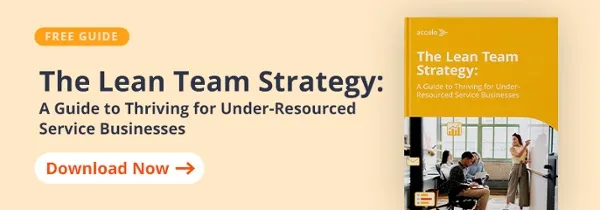Accelo Acquires Forecast, Adding Depth to AI and Capacity Planning Capabilities
Read the Press Release



Knowledge Exchange is a weekly series of educational articles that we encourage you to share and discuss with your colleagues and network. This month, we’re offering advice for making the most of limited human capital.
There are lots of things we know we should do — in life and in business. Yet, an energy of “should” around something can make it feel intimidating to get started.
Workflows may fall into that category for you, especially if you’re working with a lean team. Sure, it would be great to have your processes perfectly outlined and to have your team follow them to a T, but it could feel like you have bigger fish to fry right now.
As tedious as they may seem to set up, workflows are powerful. They can support your team by:
Despite these potential benefits, you could experience hesitation. Let’s talk about some common reasons you may feel reluctant to build workflows now and how to use this lean period of time to create them in a way that sticks.
You’re not alone in being concerned about what a new internal project will require. In fact, your worry is a sign that you’re a conscientious leader.
When it comes to the notion of generating workflows while your team is lean, you could wonder things like:
These are all reasonable questions, and many of them can be answered by learning more about workflow types and the value of automated workflows.
A workflow is more than a formula
Although workflows involve step-by-step processes, they’re way more than explicit formulas for getting things done. Collectively, your workflows create a standard for how you expect work to be performed in your business. They also serve as vital support for your team. When you think of workflows as part of a long-lasting foundation, you might be more open to dedicating the resources necessary to set them up well.
There are innumerable ways to implement workflows in every area of your business. One effective strategy for professional services is to hone in on the processes that involve clients first — your revenue-generating work.
The task
What you may do now
What an automated workflow could do
Lead capture and follow-up
Take isolated notes in a CRM
Never forget to follow up — and build a clear history with a visible trail
New client onboarding
Assign to siloed account managers
Achieve consistent replies and improve response time
Customer service
Manage requests triage-style
Standardize client service and improve satisfaction
Client billing
Manually compile work performed
Implement hands-off, accurate bulk invoicing
Project status updates
Send an email with current status
Offer access to a client portal with real-time status updates
When you prioritize the workflows that have a visible impact on your client relationships, you’ll be inspired to mirror the same efficiency across all of your internal processes.

To successfully build workflows without putting too much stress on your team, be methodical and purposeful in how you involve them.
NOTE: This endeavor could take a while when you’re being conscious of your lean team’s other responsibilities. While it’s important to keep making progress, your timeline for this significant project may be longer than you’d like — and that’s OK.
First, choose ONE task at a time (perhaps from the table above), then delineate the processes your business currently carries out to complete it. Instead of having your team do this all at once and take hours away from valuable client work in one week, provide them with guidance for how and where to easily note the step-by-step of daily tasks as they do them in real time — five or ten minutes at a time.
Once you’ve got your existing processes on paper, it’s time to identify whether each step is intentional or merely habitual. For example, is the way your team turns a quote into a project efficient or does it involve extra, unnecessary effort? Bring trusted managers or individual contributors into the conversation to avoid making assumptions.
Next, lay out only the tasks required to achieve the given outcome. The result may look sequential, or you may find out the process would be better suited for a state machine, rules-driven or other form of workflow.
Now that you know what you need, it’s time to decide how you’ll record and execute your new workflows. Remember that you already have a powerful option at your fingertips: Accelo can help your business evolve — despite limited resources — using customized and automated workflows. Read the inspiring story of DesignWorks Group.
READ NEXT: 9 Tips for Sustaining Workflows in a Professional Services Business
Repeat these steps, one process at a time, and you’ll see the impressive collective impact of marginal gains. Your business and all of its components are like a home: There will always be more you want to do to perfect it. But there’s beauty in the incremental change you and your lean team can make by doing just a few “small” things each week.
Think your colleagues would find this article valuable? Head over to LinkedIn to share and discuss how you’re responding to resource limitations.
Ready to explore more effective workflows for your team? Sign up for a free trial or schedule a demo.

